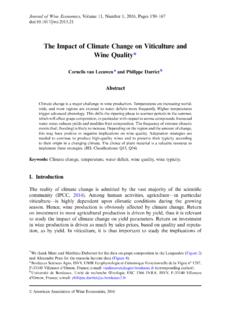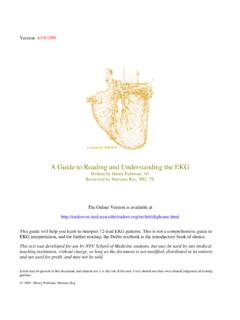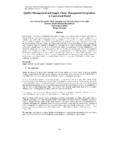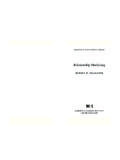Transcription of Strategic Implications of the Relationship Between …
1 Strategic Implications of the Relationship Between Priceand willingness to Pay: Evidence from aWine-Tasting Experiment*Geoffrey Lewisaand Tatiana ZalanbAbstractWe empirically examine the Relationship Between price and willingness to pay (WTP) forwines by conducting a wine-tasting experiment with a manipulation of price similar to thatused by Plassman et al. (2008); that is, with the same wines being presented at different that for non-expert wine consumers a complex interaction exists Between wineappreciation, price and WTP. The key conclusions from the study are that for non-expert wineconsumers (1) there is no Relationship Between intrinsic wine character and enjoyment(individuals rated the same wines quite differently), and (2) price influences both appreciationof wine and WTP, but the latter more strongly. Buying decisions are determined by consumersurplus (the difference Between WTP and price), and yet, for non-expert wine drinkers, WTPis itself strongly influenced by price.
2 This complex interaction Between the factors thatdetermine buying behavior has Strategic Implications for competitors in the wine industry. Wesuggest an understanding of the Relationship Between WTP and price can be used to shed lighton the crisis recently experienced by the Australian wine industry. (JEL Classifications: C91,D03, M30)Keywords:Australian wine industry, commoditization, price manipulation, willingness to pay(WTP), wine-tasting Gallo, the patriarch of the family-owned E&J Gallo Winery in California (the largestwinemaker in the world), recalls how, in the early stages of his career, he once sold wine inNew York. He offered two glasses of the same red wine to a buyer, who thereupon drank themand asked for the price of the two wines. Upon hearing that thefirst wine cost 5 cents perbottle and the second 10 cents per bottle, the buyer declared that he wanted the 10-cent message behind this anecdote is confirmed by many wine auctioneers, who have noticed American Association of Wine Economists, 2014*The authors thank Karl Storchmann and an anonymous reviewer for valuable comments.
3 The authorsare grateful forfinancial and administrative support from Melbourne Business School and the Universityof South Business School, 200 Leicester Street, Carlton, Victoria 3053, Australia; tel.: +61 8 83620621; e-mail: University of Australia, Torrens Building, 220 Victoria Square, Adelaide SA 5000, Australia;tel.: +61 8 8113 7825; e-mail: of Wine Economics, Volume 9, Number 2, 2014, Pages 115 134 in an auction room higher wine prices act as a stimulus rather than as a deterrent, therebyreflecting that, for bidders, part of the pleasure is apparently knowing that a wine is famous andvery ,2010 Veblen effects budget brands are priced at marginal cost, while luxury brands,though not intrinsically superior, are sold at higher prices to consumers seeking to advertisewealth. Luxury brands earn strictly positive profits under conditions that would, with standardformulations of preferences, yield marginal-cost and Bernheim,1996, p.
4 349I. IntroductionThe initial motivation for our experimental study is to gain a deeper understandingof the causes of the crisis experienced in the Australian wine industry in 2009(Reuters,2009). Our interpretation of the industry crisis, which we discuss in theconcluding section of the paper, hinges on the proposition that for wine consumersthere exists a Relationship Between price and their willingness to pay (WTP) for though the Relationship Between wine characteristics and WTP has receivedconsiderable attention in recent years ( , Combris et al.,2006; Gustafson et al.,2011; Oberfeld et al.,2009; Yang et al.,2009), the Relationship Between price (as theindependent variable) and WTP for wine (as the dependent variable) has not beenempirically studied. Our study addresses this Relationship and thus makes acontribution to the body of literature seeking to more fully explain wine consumers buying conducted a series of wine-tasting experiments with a manipulation of pricesimilar to that used by Plassman et al.
5 (2008) that is, unbeknown to the tasters,the same wines were presented at different prices. Wefind that for non-expert wineconsumers a complex interaction exists Between price and wine appreciation andWTP. The key conclusions from the study are that for non-expert wine consumers(1) there is no Relationship Between intrinsic wine character and enjoyment(individuals rated the same wines quite differently), and (2) price influences bothappreciation of wine and WTP (a self-reported measure), but the latter morestrongly. Buying decisions are determined by consumer surplus (the differencebetween WTP and price) and yet, for non-expert wine drinkers, WTP is itselfstrongly influenced by price. We suggest that insights into the relationships betweenprice and WTP can shed light on how managers can, through influencing consumers WTP via price cues, improve (or damage) theirfirm s competitive research has made considerable progress in examining the complexrelationship Between the factors that determine the buying behavior of wineconsumers ( , Barber et al.)
6 ,2006; Batt and Dean,2000; Charters et al.,1999;Horowitz and Lockshin,2002). Specifically, the researchers examined therelationship Between (1) price and wine characteristics (including wine quality );(2) enjoyment/subjective appreciation of wine and knowledge of wine; and (3) priceand Implications of the Relationship Between Price and willingness to PayThefindings relevant to our work from this body of research are that price iscorrelated with objective/extrinsic characteristics ( , vintage, packaging, brand)( , Ashenfelter et al.,1995; Byron and Ashenfelter,1995; Jones and Storchmann,2001; Schamel and Anderson,2001), while intrinsic/sensory characteristics havelittle effect on price (for a review, see Lecocq and Visser,2006; Unwin,1999).Following the Bagwell-Riordan (1991) hypothesis that prices can signal quality,provided that the high-quality product is more costly to produce than the lower-quality product Schnabel and Storchmann (2010) demonstrate empirically thatprice signals respond positively to wine quality.
7 In addition, the price premium fallsnonlinearly when the proportion of informed buyers increases. The implication isthat high-quality producers distinguish themselves from low-quality producers bycharging a price above the full information relevantfinding from prior research is that non-expert wine drinkershave trouble distinguishing Between good (expensive) and bad (cheap) wines,and even experts (Masters of Wine and wine judges) disagree on wine quality ( ,Ashton,2012; Hodgson,2009; Weil,2001,2005). A quotation from Robinson(2013, p. 6) illustrates the point:I tasted seven non-vintage champagnes blind with a group of professionals recently. Therewas horror when they discovered the wine most of them preferred carried a label theyregarded as their least favorite. That sort of result is especially common with champagne,arguably the most image-driven rather than quality-driven wine of all.
8 But it happens allthe time when wine is tasted , individuals who are unaware of the price of the wine that they are tastingdonotderive more enjoyment from more expensive wines and, in fact, non-experts enjoy more expensive wines slightly less (Goldstein et al.,2008). fMRIbrain scan studies (Plassman et al.,2008) demonstrate that increasing the price ofwine increases subjective reports offlavor pleasantness as well as the neuralcomputations of experienced utility made by the brain. This is consistent with theidea that because perceptions of quality are known to be positively correlated withprice (Rao and Monroe,1989), the individual is likely to expect that a moreexpensive wine will taste better (Brochet,2001; also Almenberg and Dreber,2011).In our study we focus on the Relationship Between price and WTP. In Section II,we present the conceptual underpinnings of our research. We then describe the dataand method we used in the wine-tasting experiment in Section III.
9 The results arediscussed in Section IV. Implications for the Australian wine industry andlimitations are presented in Section Price, willingness to Pay, and Buying BehaviorAs business strategists, we take as our theoretical point of departure a competitivestrategy framework grounded in microeconomics (Brandenburger and Stuart,1996;Collis and Rukstad,2008; Ghemawat,2006; Ghemawat and Rivkin,2006; Porter,Geoffrey Lewis and Tatiana Zalan1171985;1996). This approach focuses on the way in which afirm positions itself inan industry to maximize the unique value that it creates. This value equates to thefirm s competitive advantage defined as the difference Between the relative WTPthat thefirm elicits from its customers and thefirm s relative cost (in both cases, relative means compared with otherfirms in the industry).1 WTP is the maximum price that a customer is willing to pay for a product beforeswitching to a substitute (or forgoing the purchase) under the given circumstances oftime and place (Besanko et al.)
10 ,2007; Ghemawat and Rivkin,2006; Postrel,2010;Smith and Nagle,2002). WTP is not necessarily what the buyer thinks is a fair priceor what the buyer wishes to pay the buyer always prefers a lower price because thismaximizes buyer surplus, but will pay any price up to his or her WTP (Corts andRivkin, 1999). A customer s WTP is driven by a product s (or service s) valueproposition that is, its bundle of perceived benefits (or utility). Value has bothtangible and intangible components. Tangible value tends to be associated withfunctional, objective benefits, while intangible value is associated with subjective(or symbolic) attributes, such as status, uniqueness, and emotional involvement(for a discussion of the tangible and intangible components of value, see Dixit(2007)). Afirm creates a competitive advantage by choosing a Strategic position inthe industry where it can drive a wedge Between relative WTP and relative exists, in theory, an unlimited number of potential Strategic positions thatcould open up a wedge of this framework, price the focus of much of the wine research describedabove is a Strategic variable that thefirm uses to divide the value created intobuyer surplus and producer surplus.









